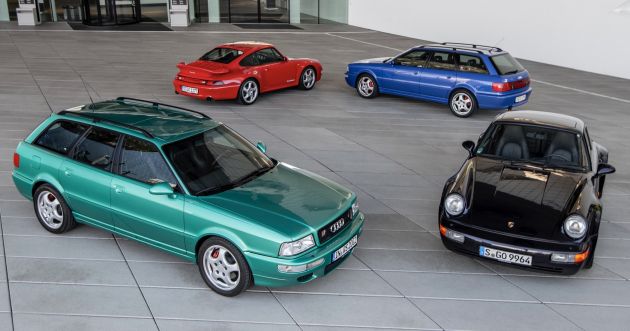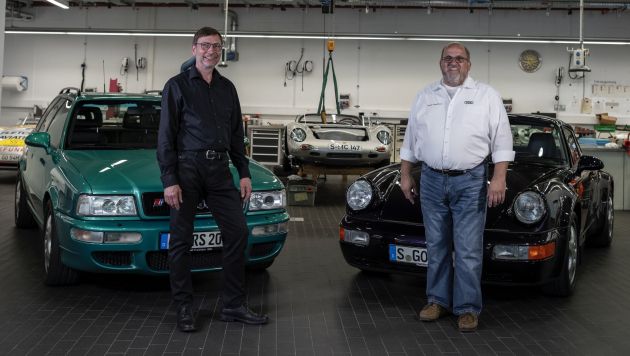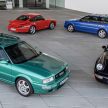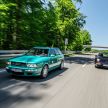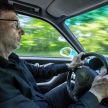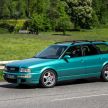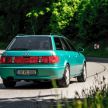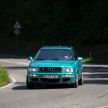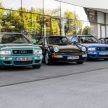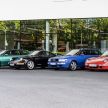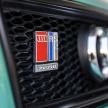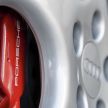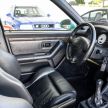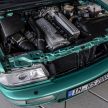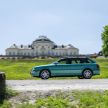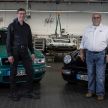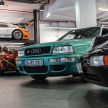Nowadays, it’s hard to imagine Porsche putting its name on another company’s car, but Zuffenhausen in the early 1990s was not the behemoth it is today. Before the successes of the Boxster and Cayenne, the company was scrounging for money, battered by the 1980s financial crisis and saddled with an ageing lineup and dismal sales.
Porsche thus outsourced its engineering and production services to other carmakers that were either incapable or unwilling to build their own specialised performance vehicles. Having worked with Mercedes-Benz from across town on the venerable 500 E in 1989, it then teamed up with a more familiar name, the Volkswagen-owned Audi, on the seminal RS2 Avant that debuted Ingolstadt’s hallowed RS moniker.
To celebrate 90 years of its Porsche Engineering consultancy, Porsche invited Audi corporate historian Ralf Friese, who brought a striking Tropic Green RS2 to the Porsche Museum. The hot wagon was Audi’s answer to the BMW M3, built by Porsche and coming with an assortment of delicious Porsche goodies.
The RS2’s project head at Porsche, Michael Hölscher, explained how the collaboration came to be. “A few years earlier, we had created the 500 E model together with Mercedes-Benz and this had boosted our profile as a development service provider thanks to fast, high-quality results,” he said. That car also helped Porsche raise production volume and tide itself over while it got its house in order.
The company was open to another similar partnership, so when Audi needed help building a performance car, it jumped at the chance. They wasted no time bringing the car to market – the RS2 made its world premiere at the 1993 Frankfurt Motor Show and went into production the following year right as the Mercedes project was being wound down, despite what Porsche says was a tight budget and schedule.
Next to the Viola Metallic 964-generation 911 that was wheeled out for the occasion, Porsche’s input on the RS2 was clear. The Audi shared its front indicators, fog lights and door mirrors with the 993, while the 17-inch five-spoke alloy wheels were lifted straight from the 964 Carrera Cup. The rollers hid Porsche-branded red brake callipers; the bumpers, dials and door handles were also designed by the company.
“Around 20% of the RS2 stems from Porsche,” Hölscher estimated. “We found it essential to make the Porsche character immediately noticeable and the associations clear.” So clear, in fact, that the company even put its name underneath the RS2 badges at the front and rear of the car.
Based on the Audi 80, the RS2 was built at the same Rössle building – which started out life churning out the 959 supercar – as the 500 E, using painted body parts and add-ons from Audi. “We were responsible for new parts and development services, while Audi took care of body parts and components that could be transferred from other models. It was an exciting collaboration that brought about nothing but benefits for both companies,” said Hölscher, who was also responsible for the 500 E and spent 32 years at Porsche.
Power came from a 2.2 litre five-cylinder engine, heavily tweaked and turbocharged to produce 315 PS at 6,500 rpm and 410 Nm of torque at 3,000 rpm – routed to Audi’s quattro all-wheel-drive system through a six-speed manual gearbox. As the output figures suggest, the mill generated a significant amount of turbo lag, which gave the RS2 a rather…unique driving experience.
“Back then and to this day, the strong, design-based turbocharger lag puts a driver under a certain amount of pressure,” Hölscher said. “Quite a few drivers were not terribly fond of the sudden push, while proud RS2 owners have always loved the turbocharger. The turbocharged engine’s response characteristics are sensational, most of all from the lower engine speed range.”
Despite the lag, the RS2 was the world’s fastest wagon upon its debut. “The RS2 was the first Audi that was not electronically limited, even though it reached speeds of more than 250 km/h. The speedometer goes up to 300 km/h and the car maxes out at 262 km/h,” said Friese, who has worked at Audi Tradition for 14 years. The monstrous powerplant enabled the car to accelerate from zero to 100 km/h in 5.4 seconds.
Having swapped cars, the two men were let loose on the roads that made up the former Solitude circuit west of Stuttgart. In his first drive of a 911, Friese said the 964 provided a “completely new driving experience,” adding that it was “a whole new world for me.”
Taking the wheel of the RS2, Hölscher said, “The outing was great fun. It seemed like old times, more than a quarter of a century ago. It’s marvellous to experience how this car can still keep up with contemporary models – and it does so in a very sporty fashion.”
Looking to sell your car? Sell it with Carro.

